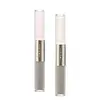What's inside
What's inside
 Key Ingredients
Key Ingredients

 Benefits
Benefits

No benefits
 Concerns
Concerns

 Ingredients Side-by-side
Ingredients Side-by-side

Isononyl Isononanoate
EmollientPolyglyceryl-2 Triisostearate
EmulsifyingPhenyl Trimethicone
Skin ConditioningSynthetic Wax
AbrasiveHydrogenated Styrene/Methylstyrene/Indene Copolymer
Mica
Cosmetic ColorantParaffin
PerfumingMicrocrystalline Wax
Emulsion StabilisingParaffinum Liquidum
EmollientSilica Dimethyl Silylate
EmollientPolyglyceryl-2 Isostearate/Dimer Dilinoleate Copolymer
EmollientAluminum Hydroxide
EmollientTriethoxycaprylylsilane
Phenoxyethanol
PreservativeTocopheryl Acetate
AntioxidantEthylhexylglycerin
Skin ConditioningCI 77891
Cosmetic ColorantIron Oxides
CI 77492
Cosmetic ColorantCI 77491
Cosmetic ColorantCI 77499
Cosmetic ColorantIsononyl Isononanoate, Polyglyceryl-2 Triisostearate, Phenyl Trimethicone, Synthetic Wax, Hydrogenated Styrene/Methylstyrene/Indene Copolymer, Mica, Paraffin, Microcrystalline Wax, Paraffinum Liquidum, Silica Dimethyl Silylate, Polyglyceryl-2 Isostearate/Dimer Dilinoleate Copolymer, Aluminum Hydroxide, Triethoxycaprylylsilane, Phenoxyethanol, Tocopheryl Acetate, Ethylhexylglycerin, CI 77891, Iron Oxides, CI 77492, CI 77491, CI 77499
Water
Skin ConditioningCyclopentasiloxane
EmollientCI 77891
Cosmetic ColorantIsododecane
EmollientButylene Glycol Dicaprylate/Dicaprate
EmollientButylene Glycol
HumectantLauryl PEG-10 Tris(Trimethylsiloxy)Silylethyl Dimethicone
EmulsifyingDimethicone
EmollientDiphenylsiloxy Phenyl Trimethicone
Skin Conditioning1,5-Pentanediol
SolventTrimethoxysilyl Dimethicone
Skin ConditioningSilica
AbrasiveCyclohexasiloxane
EmollientSqualane
EmollientCetyl PEG/PPG-10/1 Dimethicone
EmulsifyingDisteardimonium Hectorite
StabilisingSulfuric Acid
BufferingPhenoxyethanol
PreservativePolyhydroxystearic Acid
EmulsifyingPolymethyl Acrylate
Divinyldimethicone/Dimethicone Crosspolymer
Skin ConditioningHydrogen
AntioxidantAlumina
AbrasiveTriethoxycaprylylsilane
PEG-10 Dimethicone Crosspolymer
StabilisingEthylhexylglycerin
Skin ConditioningTrisodium Ethylenediamine Disuccinate
Tocopherol
AntioxidantPentaerythrityl Tetra-Di-T-Butyl Hydroxyhydrocinnamate
AntioxidantPhenyl Trimethicone
Skin ConditioningDimethicone Crosspolymer
Emulsion StabilisingGlycerin
HumectantVinyl Dimethicone/Methicone Silsesquioxane Crosspolymer
Trimethylsiloxysilicate
EmollientMica
Cosmetic Colorant1,2-Hexanediol
Skin ConditioningMethicone Crosspolymer
Polyglyceryl-4 Isostearate
EmulsifyingAmmonium Dimethicone PEG-7 Sulfate
Skin ConditioningCI 77492
Cosmetic ColorantEthyl Trisiloxane
Skin ConditioningHydroxystearic Acid
CleansingCI 77491
Cosmetic ColorantPoly C10-30 Alkyl Acrylate
Emulsion StabilisingBeeswax
Emulsion StabilisingCentella Asiatica Extract
CleansingChamomilla Recutita Extract
Skin ConditioningWater, Cyclopentasiloxane, CI 77891, Isododecane, Butylene Glycol Dicaprylate/Dicaprate, Butylene Glycol, Lauryl PEG-10 Tris(Trimethylsiloxy)Silylethyl Dimethicone, Dimethicone, Diphenylsiloxy Phenyl Trimethicone, 1,5-Pentanediol, Trimethoxysilyl Dimethicone, Silica, Cyclohexasiloxane, Squalane, Cetyl PEG/PPG-10/1 Dimethicone, Disteardimonium Hectorite, Sulfuric Acid, Phenoxyethanol, Polyhydroxystearic Acid, Polymethyl Acrylate, Divinyldimethicone/Dimethicone Crosspolymer, Hydrogen, Alumina, Triethoxycaprylylsilane, PEG-10 Dimethicone Crosspolymer, Ethylhexylglycerin, Trisodium Ethylenediamine Disuccinate, Tocopherol, Pentaerythrityl Tetra-Di-T-Butyl Hydroxyhydrocinnamate, Phenyl Trimethicone, Dimethicone Crosspolymer, Glycerin, Vinyl Dimethicone/Methicone Silsesquioxane Crosspolymer, Trimethylsiloxysilicate, Mica, 1,2-Hexanediol, Methicone Crosspolymer, Polyglyceryl-4 Isostearate, Ammonium Dimethicone PEG-7 Sulfate, CI 77492, Ethyl Trisiloxane, Hydroxystearic Acid, CI 77491, Poly C10-30 Alkyl Acrylate, Beeswax, Centella Asiatica Extract, Chamomilla Recutita Extract
Ingredients Explained
These ingredients are found in both products.
Ingredients higher up in an ingredient list are typically present in a larger amount.
Ci 77491 is also hydrated iron III oxide. It's sole purpose is to give a red/pink hue to products.
Iron III oxides are classified as inorganic chemicals for coloring.
Synthetically created Ci 77491 is considered safer than those naturally found. This is because the synthetically created version may contain less impurities. Iron oxides are generally non-toxic and non-allergenic.
Learn more about CI 77491Ci 77492 is also hydrated iron III oxide. It's sole purpose is to give a yellow hue to products.
Iron III oxides are classified as inorganic chemicals for coloring.
Synthetically created Ci 77492 is considered safer than those naturally found. This is because the synthetically created version may contain less impurities. Iron oxides are generally non-toxic and non-allergenic.
Learn more about CI 77492Ci 77891 is a white pigment from Titanium dioxide. It is naturally found in minerals such as rutile and ilmenite.
It's main function is to add a white color to cosmetics. It can also be mixed with other colors to create different shades.
Ci 77891 is commonly found in sunscreens due to its ability to block UV rays.
Learn more about CI 77891Ethylhexylglycerin (we can't pronounce this either) is commonly used as a preservative and skin softener. It is derived from glyceryl.
You might see Ethylhexylglycerin often paired with other preservatives such as phenoxyethanol. Ethylhexylglycerin has been found to increase the effectiveness of these other preservatives.
Mica is a naturally occurring mineral used to add shimmer and color in cosmetics. It can also help improve the texture of a product or give it an opaque, white/silver color.
Serecite is the name for very fine but ragged grains of mica.
This ingredient is often coated with metal oxides like titanium dioxide. Trace amounts of heavy metals may be found in mica, but these metals are not harmful in our personal products.
Mica has been used since prehistoric times throughout the world. Ancient Egyptian, Indian, Greek, Roman, Aztec, and Chinese civilizations have used mica.
Learn more about MicaPhenoxyethanol is a preservative that has germicide, antimicrobial, and aromatic properties. Studies show that phenoxyethanol can prevent microbial growth. By itself, it has a scent that is similar to that of a rose.
It's often used in formulations along with Caprylyl Glycol to preserve the shelf life of products.
Phenyl Trimethicone is a silicon-based polymer. It is derived from silica.
Phenyl Trimethicone is used as an emollient and prevents products from foaming.
As an emollient, it helps trap moisture in the skin. It is considered an occlusive.
Learn more about Phenyl TrimethiconeTriethoxycaprylylsilane is a silicone used to bind and stabilize ingredients.
As an emulsifier, it helps prevent ingredients from separating. This can help elongate the shelf life of products.
Triethoxycaprylylsilane is often used to coat mineral sunscreens ingredients to help give a better feel. It also helps reduce oxidative stress in sunscreens.
Learn more about Triethoxycaprylylsilane